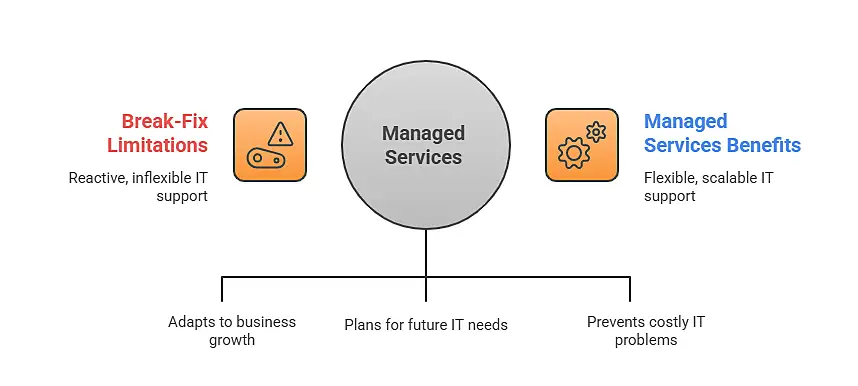Your choice of how to handle your IT support affects your whole business. IT downtime can stop your team from working and cause you to lose money fast.
According to CloudSecureTech, each minute of employee downtime costs businesses an average of $0.67 in lost wages.” This means even short outages can add up to big losses. When you decide between break-fix and managed services, you are choosing how often downtime occurs and how quickly you can fix problems.
This blog evaluates these two IT models. We’ll explain what each means in simple terms. Then, we’ll compare their benefits and risks, especially how they affect your budget, business performance, and future growth.
As Eric Hullibarger, President of AhelioTech, says, “Modern businesses need IT models that fix problems before they grow and can keep systems running smoothly every day.”
By the end of this blog, you will know which model is best for your business needs.
Move Past the Limits of Break-Fix Services with AhelioTech!Experience stability, cost control, and expert service with AhelioTech proven managed services approach. |
What Are Break-Fix Services and When Do They Work Best?
Break-fix services work on a simple idea: you only pay when something breaks or stops working. This means you do not have a monthly bill for IT support. Instead, you call your IT technician when a problem arises. This model suits businesses using a few computers or simple IT setups. It is a pay-as-you-go system where you pay for labor and parts only when needed.
For businesses with very low IT needs, break-fix services can save money because you avoid monthly fees. You get help only if there is an issue. But this comes with drawbacks. Since it is reactive, you wait for problems to appear before fixing them. This can lead to unexpected downtime, which affects productivity and causes frustration.
Here are the key points about break-fix services:
- Pay-as-you-go model: No monthly fees. You only pay when issues arise, which can save money if IT problems are rare.
- No contracts required: Call a technician when needed without long-term commitments or complex agreements.
- Delays from reactive support: Waiting for things to break leads to longer downtime and potential disruptions.
- Hard to predict costs: Budgeting may become difficult because expenses vary month to month.
- Ideal for light IT needs: Suited for small businesses or short-term setups with minimal IT reliance.
Overall, break-fix services work well if you want to avoid regular payments and have simple IT needs. But this model can cause costly downtime when problems occur unexpectedly.
What Are Managed Services and How Do They Operate?
Managed services work differently. Here, you pay a fixed monthly fee for ongoing IT support. Your provider monitors your systems round-the-clock and fixes small issues before they grow. This proactive approach keeps your IT stable and reduces downtime.
Managed services include network monitoring, regular maintenance, security updates, and planning for future IT needs. This constant care helps avoid sudden surprises and keeps your business running smoothly. You get a dedicated team focused on your IT health.
This model fits businesses that rely on technology daily and need steady, reliable support. It is common in companies that have complex IT or must adhere to security rules.
Important details about managed services include:
- Predictable monthly pricing: Fixed costs simplify budgeting and improve financial planning.
- 24/7 system monitoring: Issues are detected early, reducing the risk of downtime.
- Quick response times: Continuous oversight enables faster fixes and minimal disruption.
- Built-in security and updates: Includes patching, backups, and threat protection to keep systems secure.
- Compliance support: Helps you meet industry standards with proper controls and documentation.
- Best for tech-driven growth: Ideal for businesses that rely heavily on IT or need strong security.
Despite the monthly fee, many businesses find that managed services give better peace of mind and steady IT performance. According to a Cisco Report, managed IT services can boost efficiency by up to 50–60%.
Break-Fix vs Managed Services: Key Cost Considerations
Cost is a major factor when choosing between break-fix and managed services. Break-fix often looks cheaper upfront because you only pay for repairs. But these costs can add up when emergencies happen.
Unexpected IT failures often come with higher fees due to emergency repairs and lost work time. The 2022 ITIC Report reveals that IT downtime costs 91% of SME and large enterprises $300,000 hourly on average. These hidden costs can make break-fix more expensive over time.
Managed services charge a steady monthly fee. This predictability helps you plan budgets and reduces surprise expenses. It also lowers downtime, saving money by avoiding emergency fixes.
Key cost points to consider:
- Break-fix saves money initially but can cost more in emergencies.
- Hidden costs include urgent repair fees and lost employee productivity.
- Managed services offer fixed payments and fewer costly disruptions.
- Long-term return on investment with managed services comes from improved uptime and stability.
You must decide if you prefer risking sudden expenses or paying steady fees for reliable IT support.
How Break-Fix and Managed Services Impact Business Productivity and Security
Downtime harms business. When IT breaks, your team cannot work. With break-fix services, you often wait for a technician to arrive. This delay slows work and frustrates users.
With managed services, problems get caught early. Your provider fixes issues before they stop work. If you need help, support is fast because expert technicians constantly monitor your IT.
These two models also handle security in different ways. Break-fix fixes security only after problems show up. This can leave you open to risks longer.
Managed services protect you with constant updates and monitoring, lowering the chance of attacks and helping meet security rules.
Important points about productivity and security:
- Break-fix means longer downtime due to reactive fixes.
- Managed services reduce downtime with early detection.
- Break-fix delays security fixes, raising risk.
- Managed services offer ongoing protection and updates.
- Compliance is easier to maintain with managed services.
How Managed Services and Break-Fix Affect Flexibility and Scalability

Your business changes over time. Your IT needs will grow or shift. Break-fix services do not plan for these changes. You get help only when things break, with no support for new needs or growth.
Managed services are built to adapt. Your provider can add devices, users, or new services as your business grows. They plan upgrades and scale support to fit your future.
Many businesses begin with break-fix but migrate to managed services as they expand or need stronger IT. Knowing when to switch helps avoid IT problems.
Consider these facts about flexibility:
- Break-fix offers limited support for growth or change.
- Managed services scale with your business easily.
- Switching to managed services helps avoid costly failures.
- Managed providers help plan your IT future.
Planning for growth with the right IT model protects your business from sudden failures.
Making the Decision That Fits Your Business
You must evaluate your business needs carefully before choosing between break-fix and managed services.
Ask yourself:
- How important is IT for daily work?
- How much downtime can you afford?
- Do you have security or compliance requirements?
- Are you growing or planning new technology?
Some businesses use a mix. They have managed services for critical systems and break-fix for occasional needs. This balances control and cost.
If you want to switch to managed services, start small. Move part of your IT to test the new system. Clear communication helps keep the change smooth.
This thoughtful approach leads to better IT support with less risk.
Comparing Break-Fix and Managed Services Features
Choosing the right IT model is easier when you compare key features side by side. The table below shows differences in payment, control, response times, and more. Use it to find which model fits your business needs.
| Feature | Break-Fix Services | Managed Services |
| Payment Model | Pay only when problems happen | Fixed monthly fee |
| Control Level | You control fixes and timing | Provider manages your IT systems |
| Response Time | Depends on technician availability | Fast and proactive |
| Downtime Risk | High due to reactive fixes | Low with preventive care |
| Security | Fixes after problems appear | Continuous monitoring and updates |
| Scalability | Limited support for growth | Designed to grow with your business |
| Best For | Small, simple IT needs | Businesses needing ongoing IT support |
Use this table to see the strengths and limits of each model clearly.
Partner with AhelioTech to Move Beyond Break-Fix Services
Choosing between break-fix services and managed services shapes how your IT supports your business goals. The main takeaway is that managed services offer better stability, faster issue resolution, and more predictable costs. Businesses relying on technology need a reliable managed services provider who understands these needs.
AhelioTech stands out with 19 years in business and an average response time of just 15 minutes for high-priority issues. This means you get expert support exactly when it matters most, minimizing downtime and protecting productivity.
| Discover AhelioTech’s Range of IT Services in Ohio! | |
| Columbus | Cincinnati |
Contact us today to explore how shifting from break-fix services to managed services can save your business time, money, and stress. Schedule a consultation and take control of your IT future.








